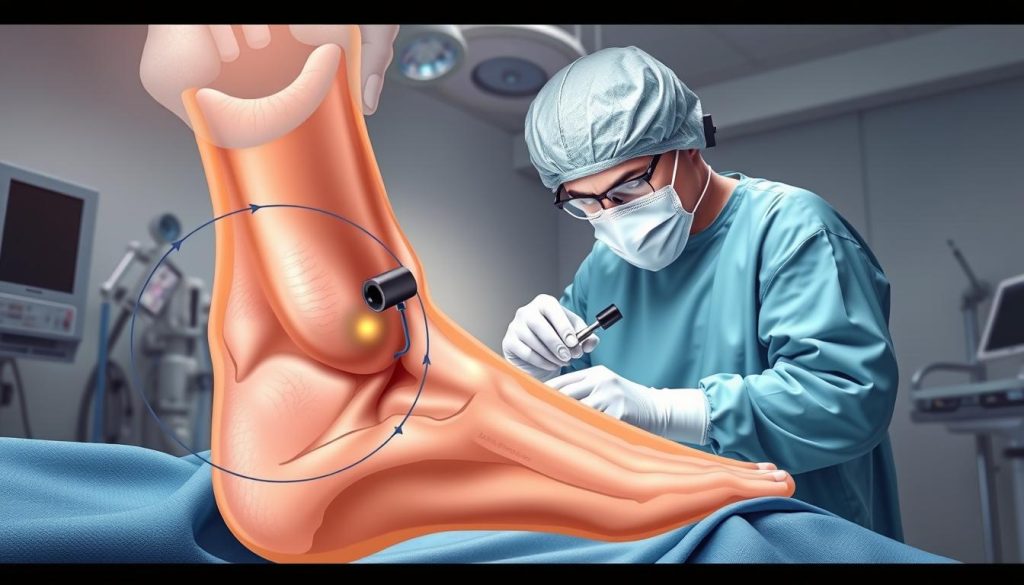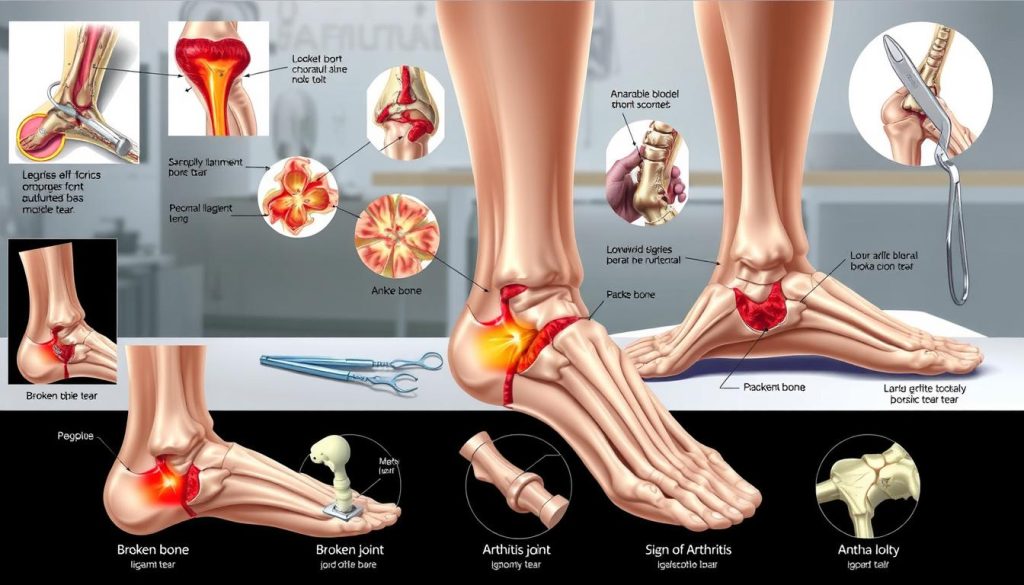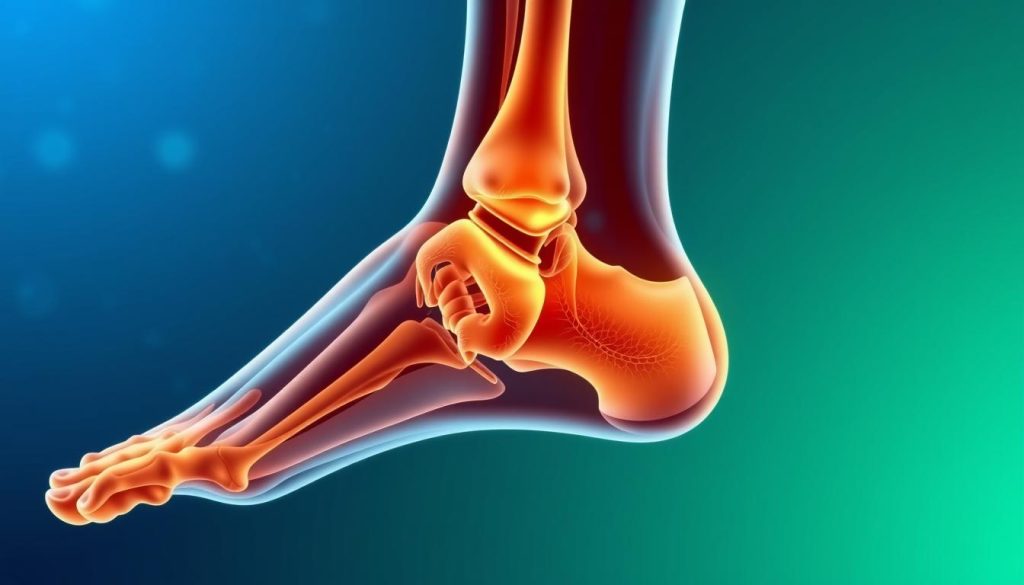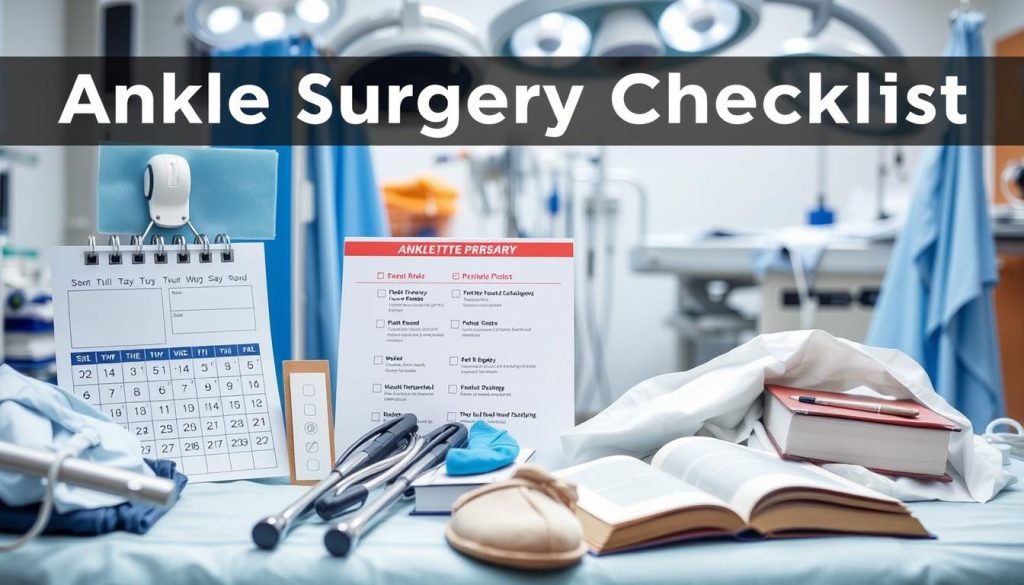Ankle surgery is a medical procedure for many foot and ankle issues. It includes ankle arthroscopy and open surgery to fix problems and ease pain. If you’re thinking about ankle surgery, it’s important to know about recovery, risks, and how to prepare.
How long it takes to recover from ankle surgery varies. It depends on the surgery type and your health. You might need weeks or months to fully recover. Risks include infection, blood clots, and nerve damage.
Getting ready for surgery means medical checks, changing your lifestyle, and planning for aftercare. Knowing all about ankle surgery helps you prepare better. Talk to your doctor to make sure you’re ready for the surgery and recovery.
Understanding Different Types of Ankle Surgery
Ankle surgery includes many procedures for different conditions. Each one is designed to help patients with ankle ligament repair or fracture treatment. These methods range from arthroscopy to open surgery.
Ankle Arthroscopy Procedures
Arthroscopy uses small cuts and a camera to look at and fix ankle problems. It’s great for removing small bone pieces, fixing cartilage, and minor ligament tears.

Open Surgical Techniques
Open surgery needs bigger cuts for direct access to the ankle. It’s used for complex fractures or big ligament repairs. Surgeons can see and work on the whole joint, making sure it’s fixed right.
Minimally Invasive Options
Minimally invasive surgeries mix arthroscopy and open surgery. They use smaller cuts than open surgery but are more flexible than arthroscopy. They work well for some ligament repairs.
| Surgical Approach | Incision Size | Recovery Time | Best For |
|---|---|---|---|
| Arthroscopy | 0.5-1 cm | 2-6 weeks | Minor repairs, diagnostics |
| Open Surgery | 10+ cm | 6-12 weeks | Complex fractures, major ligament repair |
| Minimally Invasive | 2-5 cm | 4-8 weeks | Moderate ligament repair, some fractures |
Choosing the right surgery depends on the ankle problem, injury severity, and patient health. Your doctor will pick the best option for your treatment.
Common Conditions Requiring Ankle Surgery
Ankle surgery is needed when other treatments don’t work. This is true for many conditions, from sudden injuries to long-term diseases.

Severe sprains can tear ligaments that don’t heal right. This leads to chronic instability and makes the ankle more likely to twist. An ankle tendon repair might be suggested to fix this and stop more harm.
Fractures, like those in the ankle joint, often need surgery. This ensures the bones heal right and lowers arthritis risk.
Arthritis is a big reason for ankle joint replacement. When cartilage wears off, bones rubbing together hurts and stiffens. In severe cases, a total ankle arthroplasty might be needed to replace the damaged joint.
Tendon injuries, like Achilles tendon ruptures or posterior tibial tendon dysfunction, often need surgery. These surgeries try to fix foot and ankle movement, easing pain and boosting function.
“Ankle surgery can be life-changing for patients suffering from chronic pain or instability. It’s vital to look at all treatment options and pick the best surgery for each person.”
Osteochondral lesions, which harm cartilage and bone, might need surgery if other treatments don’t work. These surgeries try to help cartilage heal or replace damaged areas with healthy tissue.
Pre-operative Assessment and Planning
Before ankle arthritis surgery or ankle instability correction, patients go through a detailed pre-operative assessment. This step is key to achieving the best results and reducing risks.
Medical Evaluation Requirements
Your doctor will do a thorough medical check-up. They will look at your medical history and current health. They will also do physical exams. This helps spot any issues that might affect your surgery or recovery.
Imaging and Diagnostic Tests
Imaging tests are very important for planning surgery. X-rays show bone structure, while MRI scans detail soft tissues. CT scans might be used for more complex cases. These tests help surgeons plan the best approach for your surgery.

Medication Adjustments
Some medications might need to be changed or stopped before surgery. Blood thinners, certain supplements, and anti-inflammatory drugs can raise bleeding risks. Your surgeon will tell you exactly what to do with your medications before the procedure.
| Medication Type | Action Required | Time Frame |
|---|---|---|
| Blood Thinners | Discontinue | 7-10 days before surgery |
| NSAIDs | Stop | 1 week before surgery |
| Herbal Supplements | Discontinue | 2 weeks before surgery |
By following these pre-operative guidelines, you’ll be well-prepared for your ankle surgery. Whether it’s for arthritis treatment or instability correction, your healthcare team will help you every step of the way. They ensure you’re ready for a successful procedure and recovery.
Step-by-Step Guide to Ankle Surgery Preparation
Getting ready for ankle surgery needs careful planning. Whether it’s for ankle deformity correction or fusion surgery, these steps will guide you. They ensure a smooth preparation process.

First, plan your time off work. Talk to your surgeon and employer about your recovery time. This will help you figure out how much leave you need.
Then, make your home ready for recovery. Clear the way, set up a comfy spot to rest, and gather what you’ll need.
Next, pack a bag for the hospital. Include comfy clothes, toiletries, and any regular medications. Remember to bring your ID and insurance info too.
- Follow pre-surgery dietary restrictions
- Stop smoking and avoid alcohol
- Arrange transportation to and from the hospital
- Prepare meals in advance for easy post-surgery eating
Mental preparation is key. Take time to relax and use stress-reduction methods. Talk to your healthcare team about any worries. This will help you feel more ready for your surgery.
The night before, follow your doctor’s fasting and medication advice. Aim for a good night’s sleep. By following these steps, you’ll be well-prepared for your surgery.
What to Expect During Ankle Surgery
Ankle surgery might seem scary, but knowing what happens can make you feel better. Whether it’s ankle arthroscopy or another surgery, being prepared helps a lot.
Anesthesia Options
Your doctor will talk to you about anesthesia. For ankle surgery, you might get general anesthesia or a spinal block. The choice depends on your health, the surgery, and what you prefer.

Surgical Duration
The time it takes for ankle surgery varies. Ankle arthroscopy usually lasts 30 minutes to an hour. More complex surgeries might take longer. Your doctor will tell you how long it will take before the surgery.
Operating Room Procedures
On the day of surgery, you’ll go to the operating room. You’ll be placed on the table and your ankle will be cleaned and prepped. If you’re awake, you might hear sounds and hear the team talking.
For arthroscopic surgeries, small cuts are made for a camera and tools. Open surgeries need bigger cuts. After the surgery, you’ll go to recovery to start healing.
“Understanding the surgical process can significantly reduce anxiety and improve overall patient experience.”
Remember, your medical team is there to help you. If you have questions or concerns, don’t hesitate to ask at any time.
Immediate Post-operative Care
After ankle surgery, patients start a key recovery phase. In the recovery room, doctors watch vital signs and manage pain. For ankle fracture treatment, nurses check the foot’s circulation and sensation often.
Pain control is a major focus. Doctors use nerve blocks, IV meds, or pills to keep patients comfortable. Ice packs also help reduce swelling and pain at the surgical site.
Wound care starts right away. Nurses clean and dress the incision, looking for infection signs. A bulky dressing or splint protects the ankle after surgery.
Patients start moving their toes and ankles gently early on, as told by their surgeon. This helps avoid stiffness and blood clots. Some may need crutches or a walker to avoid putting weight on the ankle.
- Regular pain assessment
- Wound inspection and dressing changes
- Early mobilization exercises
- Instruction on using assistive devices
Before leaving the hospital, patients get advice on at-home care. This includes managing meds, wound care, and activity limits. Follow-up visits are set to check healing and plan for rehab.
Recovery Timeline and Rehabilitation Process
The time it takes to fully recover from ankle surgery depends on the type of surgery. Whether it’s an ankle tendon repair or joint replacement, knowing the recovery timeline is important. It helps set realistic goals for your recovery.
First Week After Surgery
In the first week after surgery, rest and keeping your ankle elevated are key. You might feel swollen and sore. Always follow your doctor’s advice on medication and caring for your wound. Taking good care of yourself after is vital for healing well.
Weeks 2-6 Recovery Phase
As you get better, you’ll start doing gentle exercises and movements. If you had your tendons repaired, you might start physical therapy soon. If you had a joint replacement, you might start putting weight on your ankle again, but only with your doctor’s guidance.
Long-term Recovery Expectations
Recovering fully can take months to a year. You’ll slowly get back to doing things you normally do. People who had joint replacements might take longer to get back to full mobility than those with tendon repairs. It’s important to keep up with doctor’s appointments and follow your rehabilitation plan closely for the best results.
| Recovery Phase | Ankle Tendon Repair | Ankle Joint Replacement |
|---|---|---|
| Early (1-6 weeks) | Limited movement, protective boot | Non-weight bearing, cast or boot |
| Mid (6-12 weeks) | Physical therapy begins | Partial weight-bearing starts |
| Late (3-6 months) | Return to light activities | Continued strengthening |
| Full Recovery | 4-6 months | 6-12 months |
Physical Therapy and Exercise Protocols
Physical therapy is key after ankle surgery or instability correction. It helps patients regain strength and flexibility. Following professional advice and doing prescribed exercises is essential for a good recovery.
Rehab programs differ based on the surgery type. For arthritis surgery, exercises aim to improve joint mobility and reduce stiffness. Those with instability correction focus on balance and proprioception to enhance stability.
Common exercises in ankle rehab include:
- Ankle alphabet: tracing letters with your toes to improve range of motion
- Calf stretches: to maintain flexibility in the lower leg
- Resistance band exercises: to strengthen ankle muscles
- Balance training: using wobble boards or single-leg stands
- Gait training: to ensure proper walking mechanics
Physical therapists will increase exercise intensity and complexity as you progress. They may add functional activities that mimic daily tasks or sports-specific movements. This ensures a safe return to normal activities and reduces re-injury risk.
“Consistency in performing prescribed exercises is vital for optimal recovery after ankle surgery. Patients who adhere to their physical therapy protocols typically experience better outcomes and faster return to function.”
Remember, every patient’s recovery is unique. Your physical therapist will adjust your program based on your progress and individual needs throughout the rehabilitation process.
Potential Risks and Complications
Ankle surgery, like fixing deformities or fusing ankles, has risks. Knowing these can help patients get ready and lessen complications.
Common Side Effects
After surgery, swelling, bruising, and pain at the ankle are common. These signs usually go away in a few weeks. Some might feel numbness or tingling in their foot.
Serious Complications
Though rare, serious problems can happen. These include:
- Infection at the surgical site
- Blood clots in the leg
- Nerve damage causing persistent pain or numbness
- Failure of bones to heal properly after ankle fusion surgery
Risk Prevention Strategies
Patients can lower their risk of complications:
- Follow pre-operative instructions carefully
- Quit smoking before surgery
- Maintain a healthy diet to support healing
- Adhere to post-operative care guidelines
- Attend all follow-up appointments
| Risk Factor | Prevention Strategy |
|---|---|
| Infection | Keep incision clean and dry |
| Blood Clots | Early mobilization as advised by doctor |
| Poor Healing | Avoid putting weight on ankle too soon |
By knowing these risks and following prevention steps, patients can boost their chances of a good outcome from ankle surgery.
Pain Management and Medication Guidelines
Managing pain well is key to a smooth recovery after ankle surgery or arthroscopy. Your doctor will make a plan just for you. This plan helps you feel less pain and heal faster.
Right after surgery, you might get prescription pain meds. These could be opioids or strong anti-inflammatory drugs. It’s very important to take them exactly as told and watch out for any side effects.
- Take medications as prescribed
- Don’t exceed recommended doses
- Report any adverse reactions to your doctor
As you get better, your doctor might suggest switching to over-the-counter pain relievers. There are also non-medication ways to help with pain after surgery.
| Non-Pharmaceutical Pain Relief Methods | Benefits |
|---|---|
| Ice therapy | Reduces swelling and numbs pain |
| Elevation | Minimizes inflammation and improves circulation |
| Gentle exercises | Promotes blood flow and prevents stiffness |
| Compression | Controls swelling and provides support |
Pain management is a big part of getting better after ankle surgery. Always talk to your healthcare provider about your pain. Share any worries you have during your recovery.
Lifestyle Modifications During Recovery
Recovering from ankle surgery means changing your lifestyle to heal right. Whether it’s ankle ligament repair or ankle fracture treatment, smart changes at home and in your daily life are key. They help you recover well.
Home Environment Adaptations
After ankle surgery, making your home safe is vital. Remove things that could trip you, like loose rugs and cords. Create a comfy recovery spot with easy access to what you need.
Think about putting in grab bars in the bathroom. Also, use a shower chair to avoid slipping. These steps help prevent falls when you’re getting ready.
Daily Activity Adjustments
Change how you do daily tasks to protect your ankle. Use crutches or a knee scooter to move around. Ask someone else to do chores that need you to stand or climb.
After ankle surgery, you might need to change how you take care of yourself. This could mean sponge baths instead of showers.
Return to Work Considerations
Thinking about going back to work needs careful planning. Talk to your surgeon and boss about your job. You might need special help at work, like a parking spot or a better desk.
Start doing more things at work slowly, as your doctor says. This helps your ankle heal without any setbacks.
- Ask if you can work from home for a bit
- Use elevation to lessen swelling at your desk
- Take breaks to do the exercises your doctor told you to
By making these changes, you’ll make your home and work better for healing. This boosts your chances of a good recovery from ankle surgery.
Long-term Outcomes and Success Rates
Ankle surgeries, like tendon repair and joint replacement, often lead to good results. The success depends on the surgery type and the patient’s health.
Most people who get tendon repair see a big drop in pain and better movement. They usually get back to their usual activities in 4-6 months.
Joint replacement surgeries also show good results over time. Research shows that more than 90% of the implants work well after 10 years. Patients often feel less pain and move more easily.
| Procedure | Success Rate | Pain Relief | Function Improvement |
|---|---|---|---|
| Ankle Tendon Repair | 85-95% | Significant | High |
| Ankle Joint Replacement | 90% at 10 years | Substantial | Moderate to High |
Many things can affect how well a surgery works. These include the patient’s age, health, how well they follow up with care, and the injury’s severity. While most do well, some might need more surgeries or ongoing care.
It’s important for patients to have realistic hopes and stick to their recovery plans. This helps them get the best results and function in the long run.
When to Contact Your Healthcare Provider
After ankle arthritis surgery or ankle instability correction, knowing when to reach out to your healthcare provider is key. If you notice signs of infection like fever, unusual swelling, or discharge from the surgical site, call your doctor right away. Excessive pain that doesn’t respond to prescribed medication is another red flag.
Numbness, tingling, or changes in skin color around the operated area warrant immediate attention. These symptoms could indicate circulation problems or nerve issues. If you experience sudden shortness of breath or chest pain, seek emergency care, as these may signal serious complications.
For less urgent concerns, contact your provider if you have questions about your recovery timeline or worry about your progress. They can guide you on proper care and exercises to support healing after ankle arthritis surgery or ankle instability correction. Remember, it’s better to ask than to ignore possible problems during your recovery journey.
FAQ
Q: How long does it typically take to recover from ankle surgery?
A: Recovery time varies based on the surgery type. Patients usually need 4-6 weeks for initial healing. Full recovery can take 3-6 months. More complex surgeries, like ankle joint replacement, may need up to a year.
Q: What are the most common types of ankle surgery?
A: Common surgeries include ankle arthroscopy, ligament repair, fracture treatment, and tendon repair. More complex procedures like joint replacement or fusion surgery are also done.
Q: What are the risks associated with ankle surgery?
A: Risks include infection, bleeding, blood clots, nerve damage, and anesthesia issues. Specific risks depend on the procedure. Always talk to your surgeon about possible risks.
Q: How should I prepare for ankle surgery?
A: Start with a pre-operative medical check-up and plan time off work. Make your home ready for recovery and follow your surgeon’s advice on medications and fasting. Arrange for transportation and post-operative care too.
Q: Will I need physical therapy after ankle surgery?
A: Yes, most patients need physical therapy. The therapy’s duration and intensity vary by surgery type. It’s key for regaining ankle strength, flexibility, and function.
Q: How long will I need to use crutches or a walking boot after ankle surgery?
A: Crutches or boots use varies by surgery. For many, it’s 4-6 weeks. More complex surgeries might need longer, while simpler ones might be shorter.
Q: When can I return to work after ankle surgery?
A: Return to work time varies by surgery and job type. Desk jobs might allow 2-4 weeks off, while demanding jobs could need 8-12 weeks or more. Your surgeon will guide you based on your case.
Q: What are the signs of complications after ankle surgery?
A: Look out for excessive pain, fever, swelling, redness, warmth, discharge, numbness, and toe movement issues. If you see these, contact your healthcare provider right away.
Q: How successful is ankle surgery in treating arthritis?
A: Surgery for ankle arthritis can greatly reduce pain and improve function. Success rates vary by procedure, but many see big improvements. Ankle fusion and joint replacement have success rates of 80-90% in the right candidates.
Q: Can ankle surgery correct deformities?
A: Yes, surgery can correct ankle deformities. It aims to realign the joint, improve function, and reduce pain. Success depends on the deformity’s severity and the surgery technique.

















